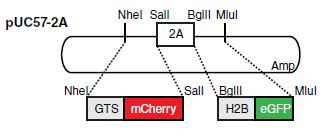Cat. #158344
pUC57-2A vector
Cat. #: 158344
Availability: Please enquire for quantities and pricing
This fee is applicable only for non-profit organisations. If you are a for-profit organisation or a researcher working on commercially-sponsored academic research, you will need to contact our licensing team for a commercial use license.
Contributor
Inventor: Dr Claudio Franco
Institute: Instituto de Medicina Molecular JoĂÂÄšÂo Lobo Antunes
Tool Details
*FOR RESEARCH USE ONLY
- Tool name: pUC57-2A vector
- Description: The two reporter sequences (for GTS-mCherry and H2B-GFP) are linked by the 2A self-cleaving peptide to allow expression of stoichiometric amounts of both fluorescent reporters. The 2A peptide-linked multicistronic vectors can be used to express multiple proteins from a single open reading frame (ORF). The small 2A peptide sequence, when cloned between genes, allows for efficient, stoichiometric production of discrete protein products within a single vector through a novel "cleavage" event within the 2A peptide sequence. 2A peptides are between 18-22 amino acids in length and have divergent amino-terminal sequences, (minimising the chance for homologous recombination. For more information see reference PMID: 22301656
Application Details
- Application notes: The two reporter sequences (for GTS-mCherry and H2B-GFP) are linked by the 2A self-cleaving peptide to allow expression of stoichiometric amounts of both fluorescent reporters. The 2A peptide-linked multicistronic vectors can be used to express multiple proteins from a single open reading frame (ORF). The small 2A peptide sequence, when cloned between genes, allows for efficient, stoichiometric production of discrete protein products within a single vector through a novel "cleavage" event within the 2A peptide sequence. 2A peptides are between 18-22 amino acids in length and have divergent amino-terminal sequences, (minimising the chance for homologous recombination. For more information see reference PMID: 22301656
Related Tools
- Related tools: pUC57-GNrep vector ; pME-GNrep vector
References
- Barbacena et al. 2019. Genesis. 57(6):e23299. PMID: 30990965.
- Szymczak-Workman et al. 2012. Cold Spring Harb Protoc. 2012(2):199-204. PMID: 22301656.




